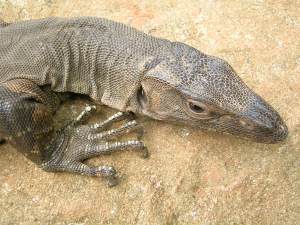Bengal Monitor (Varanus bengalensis) - Wiki Bengal monitor
From Wikipedia, the free encyclopedia
[Photo] Monitor lizard Varanus bengalensis, photographed by L. Shyamal at Wynaad, India
Bengal monitor (Varanus bengalensis), also known as the Common Indian Monitor, is a monitor lizard found throughout Bangladesh and India. It measures up to 75 cm in body length with the tail about 100 cm in length. It feeds on small terrestrial vertebrates, ground birds and their eggs, arthropods and fish.
Although not uncommon, Monitor lizards are killed for their meat and skins and are threatened in many places by hunting.
The lizard is known as Guishaap or Goshaap in West Bengal and Bangladesh, and as ghorpad in Maharashtra . The lizards have strong claws and in some parts of India this has led to the myth that they can cling strongly to surfaces. A popular legend in Maharashtra states that Shivaji's general Tanaji Malusare used a monitor with ropes attached for climbing the walls of the Sinhagad fort in the Battle of Sinhagad.
Identification
Key to South Asian Varanus species from Boulenger, Fauna of British India.
A. Nostril an oblique slit, nearer to orbit than to end of snout; tail round or slightly compressed posteriorly - V. griseus
B. Nostril an oblique slit, tail compressed, keeled above.
a. Nostril a little nearer to end of snout than to orbit - V. flavescens
b. Nostril nearer to orbit than to end of snout
a' Ventral scales smooth; supraoculars equal; nostril much nearer to orbit than to end of snout - V. bengalensis
b' Ventral scales smooth; median supraoculars slightly enlarged transversely; nostril only a little nearer to orbit than to end of snout - V. nebulosus
C. Nostril roundish or oval, nearer to end of snout than to orbit; tail compressed, keeled above - V. salvator
The Bengal monitor Varanus bengalensis can be distinguished from the Clouded monitor Varanus bengalensis nebulosus by larger scales above the eyes and fewer scales around the body.
There is considerable variation in colouration with adults being black, grey or brown with lighter patterns on the back. Hatchlings are brighter with dull orange and bold black and yellow bands on the body and tail.
The males can grow up to 100cm. The females, on the other hand, do not grow this large. It has also been found that females have a much shorter tail and lack pre-anal flaps which can be found in males as patches of scales. Populations found in drier areas are lighter in colour. When they first hatch, they appear orange or brown with yellow and black rings around the body and tail. They also have claws which people believe is used to cling onto surfaces such as trees.
Reproduction
Bengal monitors breed mostly during the wet season, but some of these animals found in Sri Lanka reproduce during December or January. In Thailand they have been known to breed throughout the year. Eggs are laid in burrows, dead logs or even in termite mounds, to give the offspring a greater chance of survival. Most young die before hatching or shortly after due to malnourishment. Young monitors feed only on insects and are normally found in trees. The siblings are likely to stay in a group together for the first few months of life.
Food
Although these creatures are relatively large in size, especially for a lizard, they mostly feed on insects such as ants, snails and beetles. They also eat animals such as ground birds, fish, frogs, snakes, other lizards and small mammals.
Distribution
Although called the Bengal Monitor, this species is among the most widely distributed of varanid lizards. It is found in river valleys in eastern Iran, Afghanistan, western Pakistan, India, Nepal, Sri Lanka, Bangladesh and Burma. A subspecies Varanus bengalensis nebulosus called the Clouded Monitor occurs in southern Burma, Vietnam, Kampuchea, Thailand, Malaysia, Sumatra, Java and the Sunda Islands.
Behavior
Bengal Monitors are usually solitary and usually found on the ground although the young are often seen on trees. V. b. nebulosus has a greater propensity for tree climbing.
Large adults may ascend vertical tree trunks where they sometimes stalk and capture roosting bats. Their normal prey consists of beetles, grubs, orthopterans, scorpions, snails, ants and other invertebrates. Vertebrate prey is comparatively rare and includes frogs, fish, lizards, snakes and rodents. Bengal monitors shelter in burrows or crevices in rocks and buildings, whilst clouded monitors prefer tree hollows. Both races will make use of abandoned termite mounds.
Males will fight each other in a bipedal fashion for females. After mating the female lays up to 30 eggs in a hollow dug in the ground and the eggs hatch in about five months. The young often remain together in loose groups and often live on trees and live on an insectivorous diet.
http://en.wikipedia.org/wiki/Bengal_monitor
| The text in this page is based on the copyrighted Wikipedia article shown in above URL. It is used under the GNU Free Documentation License. You may redistribute it, verbatim or modified, providing that you comply with the terms of the GFDL. |
